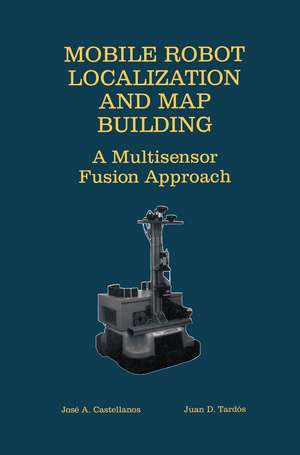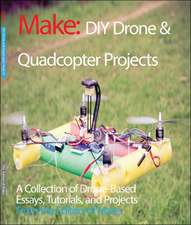Mobile Robot Localization and Map Building: A Multisensor Fusion Approach
Autor Jose A. Castellanos, Juan D. Tardósen Limba Engleză Paperback – 13 noi 2012
The main problems described throughout this book are:
- Representation and integration of uncertain geometric information by means of the Symmetries and Perturbations Model (SPmodel). This model combines the use of probability theory to represent the imprecision in the location of a geometric element, and the theory of symmetries to represent the partiality due to characteristics of each type of geometric element.
- A solution to the first location problem, that is, the computation of an estimation for the mobile robot location when the vehicle is completely lost in the environment. The problem is formulated as a search in an interpretation tree using efficient matching algorithms and geometric constraints to reduce the size of the solution space.
- The book proposes a new probabilistic framework adapted to the problem of simultaneous localization and map building for mobile robots: the Symmetries and Perturbations Map (SPmap). This framework has been experimentally validated by a complete experiment which profited from ground-truth to accurately validate the precision and the appropriateness of the approach.
| Toate formatele și edițiile | Preț | Express |
|---|---|---|
| Paperback (1) | 941.05 lei 6-8 săpt. | |
| Springer Us – 13 noi 2012 | 941.05 lei 6-8 săpt. | |
| Hardback (1) | 947.04 lei 6-8 săpt. | |
| Springer Us – 30 mar 2000 | 947.04 lei 6-8 săpt. |
Preț: 941.05 lei
Preț vechi: 1147.63 lei
-18% Nou
Puncte Express: 1412
Preț estimativ în valută:
180.09€ • 195.55$ • 151.28£
180.09€ • 195.55$ • 151.28£
Carte tipărită la comandă
Livrare economică 22 aprilie-06 mai
Preluare comenzi: 021 569.72.76
Specificații
ISBN-13: 9781461369820
ISBN-10: 1461369827
Pagini: 224
Ilustrații: XIII, 205 p.
Dimensiuni: 155 x 235 x 12 mm
Greutate: 0.32 kg
Ediția:1999
Editura: Springer Us
Colecția Springer
Locul publicării:New York, NY, United States
ISBN-10: 1461369827
Pagini: 224
Ilustrații: XIII, 205 p.
Dimensiuni: 155 x 235 x 12 mm
Greutate: 0.32 kg
Ediția:1999
Editura: Springer Us
Colecția Springer
Locul publicării:New York, NY, United States
Public țintă
ResearchDescriere
During the last decade, many researchers have dedicated their efforts to constructing revolutionary machines and to providing them with forms of artificial intelligence to perform some of the most hazardous, risky or monotonous tasks historically assigned to human beings. Among those machines, mobile robots are undoubtedly at the cutting edge of current research directions. A rough classification of mobile robots can be considered: on the one hand, mobile robots oriented to human-made indoor environments; on the other hand, mobile robots oriented to unstructured outdoor environments, which could include flying oriented robots, space-oriented robots and underwater robots. The most common motion mechanism for surface mobile robots is the wheel-based mechanism, adapted both to flat surfaces, found in human-made environments, and to rough terrain, found in outdoor environments. However, some researchers have reported successful developments with leg-based mobile robots capable of climbing up stairs, although they require further investigation. The research work presented here focuses on wheel-based mobile robots that navigate in human-made indoor environments.
The main problems described throughout this book are:
The main problems described throughout this book are:
- Representation and integration of uncertain geometric information by means of the Symmetries and Perturbations Model (SPmodel). This model combines the use of probability theory to represent the imprecision in the location of a geometric element, and the theory of symmetries to represent the partiality due to characteristics of each type of geometric element.
- A solution to the first location problem, that is, the computation of an estimation for the mobile robot location when the vehicle is completely lost in the environment. The problem is formulated as a search in an interpretation tree using efficient matching algorithms and geometric constraints to reduce the size of the solution space.
- The book proposes a new probabilistic framework adapted to the problem of simultaneous localization and map building for mobile robots: the Symmetries and Perturbations Map (SPmap). This framework has been experimentally validated by a complete experiment which profited from ground-truth to accurately validate the precision and the appropriateness of the approach.
Cuprins
Preface. Acknowledgements. 1. Introduction. 2. Uncertain Geometric Information. 3. Segment-based Representation of Indoor Environments. 4. Detecting High-Level Features by Multisensor Fusion. 5. The First-Location Problem. 6. Simultaneous Localization and Map Building. 7. Conclusions. A. Transformations and Jacobian Matrices in 2D. B. Operations with Uncertain Locations. C. Geometric Relations. D. Experimental Equipment. Bibliography. Index.












